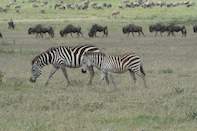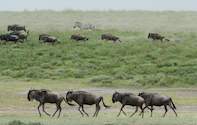
The great migration cycle has no specific beginning or end, other than as with the cycle of life, with the birth of each animal.
Early all the female wildebeest drop their young, as many as 400,000, in the short dry season (December to February) within a few weeks of each other. This creates an overwhelming food glut for the predators, the strategy of which is to leave them satiated and allow the great majority of the wildebeest herd a good chance of survival ... for the time being.
Creating a food glut is one of nature's responses to extreme predation, but it is usually confined to the more lowly creatures of the oceans, such as fish and the like, which spawn in great clouds of eggs and sperm as a defence mechanism. On land, we are more used to seeing survival strategy employed by certain types of insects and their kin. To witness it among large land mammals is a rare thing.
Dance of Life and Death

When the long rains start, usually in March, the herd begins a lengthy migration, arriving at the Mara River that defines the border between Tanzania and Kenya around late August/September. Nothing portrays the explosive violence of the dance of life and death more than when the herds cross the Mara River on their annual trek, as they follow the rains and new growth of grass.
For days wildebeest and zebras converge on the riverbank in their tens of thousands. They approach the river, turn back and then turn back again. Not only are they undecided about whether to cross or not but also about which of several potential planes along the river to use. But cross they must.
Pushed from behind by an animal tide, they eventually pour down the bank and plunge into the water. At this point they, are brave not only the possibility of being swept away and drowned by the current or breaking a leg on submerged rocks, but also being eaten by huge crocodiles that have been waiting for months in anticipation of this windfall.
And then, on the far bank, a new band of predators awaits, which take advantage of the frenzy and confusion amongst the herds, the sheer number of animals and the volume of noise adding to the mayhem. Mothers are separated from babies and babies from mothers and some promptly re-cross the river, with all its risks, in a frantic search for their offspring. On the Serengeti plains during the migration every creature is fat, but death always comes suddenly, whether herbivore or predator.
As Bernhard Grizmek foresaw: "In the coming decades and centuries, we will not travel to view marvels of engineering, but the dusty towns in order to behold the last places where God's creatures are peacefully living. Countries that have preserved such places, will be envied by others visited by streams of tourists. "
And because of this, on our watch, Serengeti shall not die.
By David Bristow

 Serengeti National Park Safari Lodges in Tanzania. The Serengeti National Park lies in northwestern Tanzania. See Serengeti National Park sa...
Serengeti National Park Safari Lodges in Tanzania. The Serengeti National Park lies in northwestern Tanzania. See Serengeti National Park sa... The Serengeti is the largest National Park in Tanzania, and one of Africa's premier game parks.The Serengeti plains are the setting for the ...
The Serengeti is the largest National Park in Tanzania, and one of Africa's premier game parks.The Serengeti plains are the setting for the ...